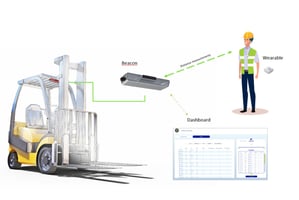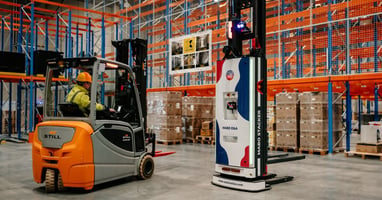A lot is at stake when it comes to warehouse safety; employee well-being, business operations,...
9 Dangers To Look For When Working Near a Forklift

Forklifts are essential for lifting and transporting goods of all sizes and weights. They operate using a hydraulic system to raise and lower items efficiently. Operators must master the controls to ensure safe handling and maneuverability.
However, these powerful machines can pose significant risks if not managed properly. If you’re in a warehouse, here are the dangers you must look for when working near a forklift.
1. Unstable Attachments
Forklift attachments are devices added to the forks to aid in specific tasks. These attachments can range from clamps to rotating devices. However, when attachments are not securely fastened or when lifting items above the capacity, the risk of accidents increases. Workers may face falling loads or tipping forklifts, endangering everyone nearby.
2. Driving in Reverse
Navigating the warehouse in reverse is necessary for forklifts. This maneuver increases the risk of accidents because of the driver's limited view. Obstacles, other workers, or equipment might go unnoticed and cause collisions.
Drivers must always use mirrors and look over their shoulders to minimize these risks. Workers should also be trained to recognize the dangers of reverse driving and stay alert.
3. Narrow or Cluttered Spaces
Operating forklifts in confined or cluttered areas adds another layer of danger. Limited space means little room for error, increasing the chance of hitting objects or employees.
Narrow pathways and excessive clutter can obstruct the operator's view and path, making navigation challenging. It's valuable to routinely clean and organize these spaces to reduce the risk of accidents and simplify forklift operation.
4. Working Near Docks and Ramps

The elevated surfaces and potential for uneven ground of docks and ramps add complexity to forklift operation. Workers might not anticipate the movement of forklifts on these inclines.
Operators should take extra caution when navigating docks and ramps. They must double check that the area is clear of personnel before proceeding.
5. Driving Too Quickly
Motorized vehicles are dangerous, especially when operated at fast speeds, which puts machinery, storage items, and people in harm’s way. Forklifts moving too quickly can compromise stability and increase stopping distances. Therefore, it’s especially difficult to avoid collisions.
The recommended speed for forklifts typically ranges between 3 to 5 mph in warehouses. Operators must adhere to speed limits and practice cautious driving.
6. Poor Ground Conditions
Slick or cluttered floors pose a significant risk for forklifts. Poor ground conditions can cause forklifts to skid or lose balance, endangering both the operator and nearby workers. Regularly inspect and maintain floor conditions by keeping them clear and dry.
7. Obstructed Views
Forklifts navigating areas with overhead beams or low-hanging objects risk collisions. Ground-level obstructions, like pallets or packaging materials, also impede visibility. Operators should proceed slowly and utilize spotters. Ensuring the path is clear before operation is necessary to avoid accidents.
8. Limited Lighting
People are in danger of forklift operation when dim or inadequate lighting hampers the operator's ability to see obstacles. Warehouses must maintain proper illumination in all areas to facilitate safe movement. Resolving illumination issues is vital to maintain a safe working environment.
9. Forklift Blind Spots
Forklift blind spots are perilous zones that can lead to severe accidents if not properly managed. These blind spots include areas directly behind the forklift or in the operator's peripheral vision. Pedestrians must exercise caution and stay clear of these zones to avoid accidents. Operators should use tools like mirrors and cameras to monitor blind spots and reduce the risk of collisions.
How To Stay Safe Around Forklifts
The dangers to look for when working near a forklift demand thorough precaution. Here are some best practices and technologies to incorporate to protect everyone in the warehouse.
Follow the Halo Rule of Forklifts
The “halo rule” refers to maintaining a safe distance around operating forklifts. Always stay at least three feet away from any moving forklift to avoid accidents. This buffer zone allows operators to maneuver without risking collisions or injuries. In a busy warehouse, it is easy to become distracted and inadvertently step into a forklift's path. By consistently practicing the halo rule, workers can reduce the risk of accidents.
Implement Forklift Proximity Warnings
Forklift proximity warning systems are an effective way to alert workers and operators of potential hazards. These systems use sensors to detect the presence of people or objects within a certain range of the forklift. When a potential hazard is detected, the system emits an audible or visual warning, alerting the operator to take corrective action.
Investing in forklift proximity warning systems can significantly reduce the risk of accidents in your warehouse. These systems are especially useful in high-traffic areas where visibility is limited. By providing operators with real-time information about their surroundings, these systems can help prevent collisions and other incidents.
Establish Pedestrian Walkways

Forklifts must use heightened caution when crossing pedestrian walkways. But first, you must establish the path, so the forklifts know where to proceed with discretion.
When planning pedestrian walkways, consider the layout of your warehouse and the typical flow of traffic. Ensure that walkways are wide enough to accommodate foot traffic and are free from obstacles.
Next, consider how you want to form the walkway. Warehouses can paint stripes on the ground, laser walkways, or LED walkways. The brighter the signal, the less likely accidents will occur.
Install Better Lighting Systems
A high-quality lighting system is exactly what warehouses need to mitigate collisions. Driving in reverse or navigating through barriers is less risky when obstructions are visible.
Evaluate the current lighting in your warehouse and identify areas that may require improvement. Focus on high-traffic zones, intersections, and areas with heavy forklift activity. Use bright, energy-efficient lights to provide consistent illumination throughout the workspace.
Motion-activated lighting can be particularly useful in areas with variable traffic. These lights turn on automatically when they detect movement.
Forklifts are a key part of warehousing. Logimate is committed to supporting warehouse safety in all regards. You can find the best safety technology to protect personnel and products.
At Logimate, you’ll find LED and laser walkways, comprehensive lighting systems, forklift proximity sensors, and forklift safety lights. Visit our website to learn about each of these items and how they can transform your warehouse into a safer, more efficient environment.




